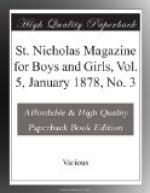WESTMINSTER ABBEY.
BY CHARLES W. SQUIRES.
I have no doubt that most of the readers of ST. NICHOLAS have heard of the grand old Abbey of Westminster, in London, and that they would be glad to visit this famous historical place. I had often been there in my thoughts and dreams, and had often wished that I might really walk through its quiet aisles and chapels, when, at last, I should make a trip to Europe. And my wish was granted.
It was on a November morning—one of those dark, gloomy mornings, peculiar to London, that I started from my lodgings to walk to the Abbey. As I said before, I had often been there in my imagination, and, as I walked slowly along, I could hardly realize that I was actually about to visit it in person. After a while I came in sight of Westminster Bridge and the Houses of Parliament, and then, on my right, I noticed two tall towers, and without the help of my guide-book I knew that they must belong to the Abbey; so I quickened my steps until I had gained the entrance door. What a change I experienced as I stepped from the busy, crowded streets, into this old sepulcher, so celebrated for its relics of the dead! It almost made me shudder, for the interior of the building was dark and gloomy, and I saw many cold, white figures towering high above me. The original Abbey was built many, many years ago, and has been restored from time to time by the succeeding kings and queens of England, until we find it in its present condition, safe and sound, and one of the greatest, if not the greatest object of interest in the city of London.
[Illustration: INTERIOR OF WESTMINSTER ABBEY.]
[Illustration: SHRINE OF EDWARD THE CONFESSOR.]
Westminster Abbey may certainly be called a tomb, for we could spend a whole day in simply counting its monuments. There were so many of these that I hardly knew which to look at first, but I thought it best to follow my own inclinations, and so, instead of procuring a guide (men with long gowns, who take visitors around and point out the objects of greatest interest), I roamed about at my will. The first monument that attracted my attention was the venerable shrine of Edward the Confessor, in the chapel of St. Edward, once the glory of the Abbey, but which has been much defaced by persons who were desirous of obtaining a bit of stone from this famous tomb. In this chapel I saw also the old coronation chairs, in which all the reigning sovereigns of England, since Edward I. have been crowned. They are queer, old-fashioned chairs, made of wood, and not very comfortable, I imagine. The older of the two chairs was built to inclose the stone (which they call Jacob’s pillar) brought from Scotland by Edward, and placed in this chapel. Many other interesting tombs are to be seen here, and the floor of the chapel is six hundred and fourteen years old!
[Illustration: TOMB OF HANDEL.]




